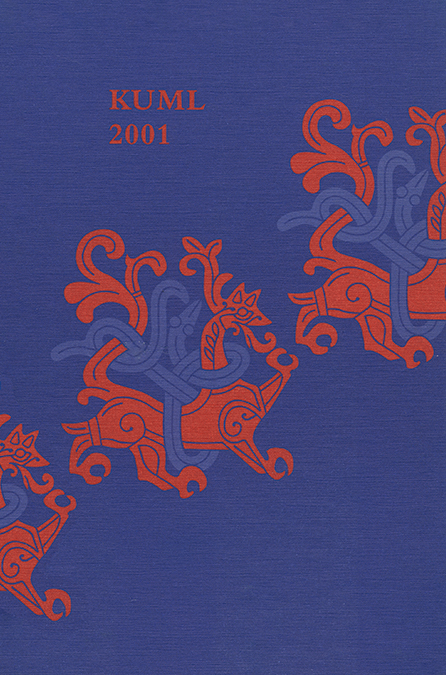Museer i oprør – Provinsmuseerne og Nationalmuseet i en brydningstid
DOI:
https://doi.org/10.7146/kuml.v50i50.103159Nøgleord:
provinsmuseer, Nationalmuseet, brydningstidResumé
Museum crisisThe provincial museums and the National Museum at a time of change
Sophus Müller (1846-1934) was one of the more controversial leaders in the Danish museum world. He was employed as a museum keeper at the Old Nordic Museum in 1885 in connection with the death of its renowned leader, J.J.A. Worsaae, who was succeeded by C.F. Herbst. The new keeper was entrusted with many administrative tasks, one of which was the handling of the relationship between the National Museum and the then seven provincial museums: Ribe (founded 1855), Århus (1860), Odense (1860), Viborg (1861), Aalborg (1865), Randers (1872), and Maribo (1879).
The relation ship between the former museum leaders – C.J. Thomsen and Worsaae – and the provincial museums had been characterised by mutual respect and helpfulness, but with Sophus Müller the relations became strained and marked by conflicts (figs. 1-2).
From 1885, the provincial museums applied annually for state subsidies on the grounds that they wanted to prevent the trade and export of artefacts. In April 1887, the Ministry for Ecclesiastical and Educational Affairs brought out a report stating the future rules for state subsidy for provincial museums. These rules were drawn up by Sophus Müller and discussed at a meeting in Aalborg in 1887 – the first joint meeting between museums of cultural history in the country. The representative of the provincial museums was Gustav Lotze from the muse um in Odense. He was especially concerned about the demand of state supervision with the provincial museums. Nevertheless, the museums were unprepared and so the outcome of the meeting was a bland letter to the ministry, which consequently paid no attention to the approach (fig. 3).
Sophus Müller’s administration of the 1887-rules was strongly challenged by many provincial museums, who resented the lack of cooperation, the trammels concerning the right to carry out excavations and the duty to hand over important finds to the museum in Copenhagen. The last issue especially caused concern and frustration, but it never became a topic at the official meetings between the leaders of the National Museum and the provincial museums, which took place in Århus in 1894 and in Copenhagen in 1897. The frustration thus never led to any change in the conditions for the provincial museums, mainly because the museum leaders disagreed about the demands to be made on the National Museum. In 1912, the same negative destiny befell an excessive proposal from the museum in Randers (figs. 4-5).
Sophus Miüller was a competent archaeologist, but his managerial style regarding administration was never popular with the provincial museum s nor with the National Museum staff Also, he was extremely unpopular with most of the antique dealers trading in artefacts allover the country. Of these and the farmhands that plundered the burial mounds he was an implacable enemy. Sophus Müller never learned how to tackle these people, nor did he ever understand their way of thinking. In this respect he had great support from the provincial museums and from the few private individuals that acted as the links between him and the population (figs. 6-7).
The era when Sophus Müller was the leader of the Danish museum system was also one of great change in the Danish society. Industry was booming and about to bring new wealth to the country and both the formations of parties and the democratisation process were developing. Sophus Müller, who was a genuine Copenhagener and very conservative, found it difficult to keep up with these changes. The fact that the farmers were gaining power through ”venstre” (a Danish Liberal political party) troubled him (fig. 8). Another problem was his severe hardness of hearing, which contributed to isolating him from the social life. Consequently, he devoted him self to work and research.
Sophus Müller continued his archaeological research for many years following his retirement in 1921. His last work, a treatise on the Iron Age, was published in 1933. He died a few months later, in February the following year.
Niels Løgager Nielsen
Gasmuseet
Translated by Annette Lerche Trolle
Downloads
Publiceret
2001-08-01
Citation/Eksport
Nielsen, N. L. (2001). Museer i oprør – Provinsmuseerne og Nationalmuseet i en brydningstid. Kuml, 50(50), 111–158. https://doi.org/10.7146/kuml.v50i50.103159
Nummer
Sektion
Artikler
Licens
Fra og med årgang 2022 er artikler udgivet i Kuml med en licens fra Creative Commons (CC BY-NC-SA 4.0).
Alle tidligere årgange af tidsskriftet er ikke udgivet med en licens fra Creative Commons.


